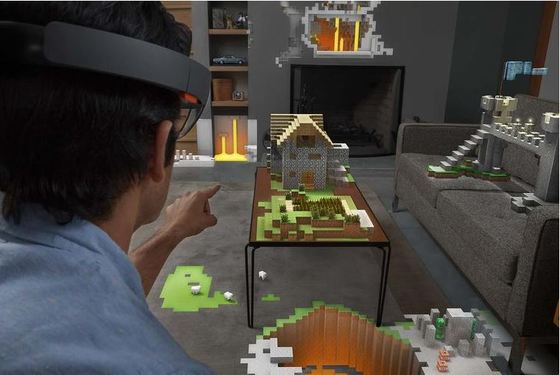|
As I mentioned yesterday, Microsoft held its major event on Wednesday to present Windows 10, which is due later this year. I watched the whole thing which streamed online and lasted about 2-1/4 hours. It was good and mediocre -- but the good was largely the substance, while the mediocre was some of the presentation. (Lest you have any questions about my opinion on all this, the title of a CNET article here about the event is titled, "It May Just Be Everything That Windows 8 Should Have Been.") As I noted, I've various reports of Microsoft's upcoming major operating system update, and it looks extremely impressive. I happen to like the current Windows 8.1 a great deal, though I know there are people who were a bit confused or put-off by the blending of a desktop operating system and a mobile one. (While I understand some of the confusion, I'm also a bit surprised by it, as well -- after all, Apple has two operating systems, OSX and iOS, and people seem to be able to handle them quite easily.) Also, much of the reaction to Windows 8 came from the initial release -- the 8.1 update addressed a lot of that. But Windows 10 goes light-years farther in addressing the issues. What it does is blend the comfortable, well-liked Windows 7 desktop software more closely with the changes in Windows 8, to make everything a much, much more familiar experience. For starters, it brings back the Start button, whose disappearing probably caused the most angst from Windows users. Also, and this is huge, it allows users to work with "Metro apps" on the familiar desktop, no longer having to switch between the desktop and mobile interface. Metro apps, which are "Live Tiles" (the live part meaning that updated information can be displayed on them, let news headlines, sports scores or stock tickers) can even be embedded on the Start button. Speaking of Metro apps, one of the issues that some people had with them is that they could only open and be run in full-screen. Now they will be called "Universal apps," and will be re-sizable, just like any window of yore. Grab the corners of a window, and make it any size you want, and drag it around your screen to move it to wherever is most convenient. They will also be added Cortana to Windows 10. This is the Siri-like voice application that's only available on Windows Phones right now. Though it's the last one to the table (after Google Now, as well), reviews have given it raves and called it possibly the most sophisticated. The upgrades described at the event seem even more impressive, including allowing you to access your files by voice. But the biggest change and easily the most noteworthy is that the software will now use a process called "Continuum" which will recognize what device you're using and adjust everything accordingly. So, there's no longer a Windows operating system and a Windows Phone operating system or being confused about which view you're in. There will only be Windows -- one Windows. And it will run on on everything the same, desktops, tablets, touch-screen laptops and phones, recognizing what kind of device it's on and even if there's a keyboard attached, and then automatically adjusting for the size and system accordingly. If you're using a touch tablet and attach a keyboard, a box will pop-up and ask if you now want to switch to desktop view. (You can say "No," if you like...) As I said, though, I did have some problems with the presentation of the event. For instance, Microsoft should have streamed the Q&A afterwards, because I read some very interesting tweets and blog postings that came from it. The thing that most intrigued me from the Q&A is how combining the Windows Phones operating system to the exact same O.S. for all Windows is what might very well make the phone platform significantly more valuable for app developers, since they'll now be creating apps not just for the phones with their small number of users compared to iOS and Android, but for a market that now will reach the full Windows user-base, which hovers around 100 million. But that got left out of the presentation. Another poor decision: if I had to bet cash-money it would be that the Cortana segment was using a real person talking, not Cortana itself, which is not a good idea. Sort of cheesy. Also, while they focused at the start about changes to Windows 10 is and how it will be improved from Windows 8, they put far too much much attention on the 3rd-party hardware that will be developed to work with the the new operating system -- most especially the Surface Hub, Xbox games and (mainly) the HoloLens for hologram usage. This hardware is definitely important – mainly Xbox, since games can bring people to the platform – and should have been dealt with, of course, just not so extensively. The problem is I suspect that the Windows 10 Hub and Xbox and holograms is what will most be remembered and written about, rather than, “Okay, you had issues with Windows 8, but here’s why we fixed that.” And it's the latter issue that, right now, is the most important by far. And they did seem to address though issues, but just overwhelmed them with the whizbang hardware. By the way, the hardware does look great. I read an article here on CNET by Nate Ralph who explains that he's a big skeptic about Virtual Reality products, but was blown away testing Microsoft's 3D HoloLens goggles after the event. Among other things, he describes a test-run he was given that showed HoloLens technology blended with something as basic as a Skype phone call. For the test, "friend" called him, and with both participants using HoloLens and connected over Skype, he writes, "His video feed followed my gaze, but I could also pin him to a spot in the air in front of me and keep him in place while I looked around the room. All the while he could see everything I could, and proceeded to draw instructions in the air in front of me." This is part of the problem, though. It's pretty impressive technology and got so much of the attention. But it's SO secondary to what the public cares about in upgrading to Windows 10 when it comes along. And yet it got a full article, and it's probably what a lot of people want to read about. Hey, this is even the only graphic that I included in this article. (In fairness, I've posted other Windows 10 pictures earlier -- though those were earlier, not part of any Big Event that Microsoft was putting on, for which they wanted to draw huge attention to Windows 10 -- not 3D hologram goggles.)
Still, those quibbles are about presentation. What was substantive came across very impressively. Windows 10 is expected to be delivered to third-party developers this summer, with release to the general public later in the year. I can't wait...
0 Comments
Leave a Reply. |
AuthorRobert J. Elisberg is a political commentator, screenwriter, novelist, tech writer and also some other things that I just tend to keep forgetting. Feedspot Badge of Honor
Archives
June 2024
Categories
All
|
|
© Copyright Robert J. Elisberg 2024
|







 RSS Feed
RSS Feed